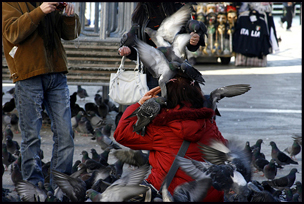 By PAT HARTMAN
By PAT HARTMAN
News Editor
Peter Ackroyd is a fellow who recently experienced a dramatic change of focus: after writing many books about London, England, he now anticipates the publication of Venice: Pure City, by the venerable British firm Chatto & Windus. The tale of this book is told to us by Peter Popham, by way of The Independent. Popham is no shabby wordsmith himself. One of the things he tells us about Venice is:
A lot of the magic resides in the silence…to wake in the morning knowing you are in a crowded city, and not to hear a single cough or roar or growl of an internal combustion engine. That alone is the worth the price of the air ticket.
Also, much of the appeal of Venice seems to be in its refusal and/or inability to change. It’s one of the few places on earth where a 16th century time-traveler could wind up and still be able to navigate the streets. Paradoxically, another part of the attraction is the city’s ability to get you good and lost, which has been exploited by several novels and feature films. And in a third aspect of that permanence is the impermanence, the instability, the precariousness of the city’s footings when confronted by the sea. One of the reasons to go to Venice has always been the “last chance” factor, the possibility that next time, it won’t be there.
And, to add a fourth layer of ambiguity, Ackroyd explains in his book how Venice was once as much a token of the shining future as any World’s Fair full of monorails and robot houses. Popham, in his review, says that during the Middle Ages and the Renaissance, Venice was “an avant-garde place which was demonstrating, boldly and with stunning success, entirely new ways of getting rich and flaunting and enjoying the wealth created.” Kind of like the dot.com era.
In a bonanza for the literary travel aficionado, this article lists several writers and artists in other fields who have been inspired by Venice, and exactly what they did about it: Shakespeare, Sir Elton John, Robert Browning, Henry James, John Ruskin, Nicholas Roeg, and of course the notorious Lord Byron. Apparently, Venice recalls its vanquishment by Napoleon in 1797, like the American South remembers the War Between the States. Ackroyd points out that there was a time when a third of its population existed on charity. This was the scene the Romantic poets descended upon, proceeding to romanticize the ruin of a formerly great principality.
The decades rolled on and Venice became a cultural center again, with all its film festivals and Biennales. It’s always been a capital of commercialism, which tourists are quite acclimated to. Reportedly, around 16 million visitors throng to Venice each year. For various reasons. On August 28, counterculture icons and artistic collaborators Annie Sprinkle and Elizabeth Stephens celebrated their Blue Wedding in Venice. Not their first wedding, but their fifth. There’s a whole high-concept performance art thing going on here, which is worth looking into. Details and great pictures come from Greg Archer (who writes about film, TV, and the arts in general, as well as ecological matters) at HuffPost.
Yes, there’s always the romance of Venice. In The Third Tower Up From the Road, Kevin Dolgin relates the story of his first visit — long before meeting his wife, it should be noted.
We spent our days walking through the tiny streets, pausing on the bridges, chasing the pigeons, and we spent our evenings riding the vaporetti, strolling through the piazze, eating sparingly in sidewalk cafés and making love in the large soft bed.
Irresistible! As long as there are canals, hotels, and cafés, Venice will never go out of business.
photo courtesy of Chiara Marra, used under this Creative Commons license


 By PAT HARTMAN
By PAT HARTMAN Then there’s the Piazza San Marco, in Venice, Italy, where you can get up close and personal with more pigeons than you ever imagined possible. The “living room of Europe” is visited by 2 million people in the average year, and by thousands of pigeons who don’t wear diapers, if you take my meaning. The Piazza also contains lots of outdoor cafes, where the conjunction of food and salmonella bacteria makes some travelers more than a little nervous. A single pigeon produces approximately 26 pounds of you-know-what every year, which is not only bad for people, but corrosive to the historical monuments that also populate the enormous square. The city has taken measures, like banning the vendors who sell pigeon-feed grain to tourists, and forbidding the locals to throw rice at the bride and groom after weddings.
Then there’s the Piazza San Marco, in Venice, Italy, where you can get up close and personal with more pigeons than you ever imagined possible. The “living room of Europe” is visited by 2 million people in the average year, and by thousands of pigeons who don’t wear diapers, if you take my meaning. The Piazza also contains lots of outdoor cafes, where the conjunction of food and salmonella bacteria makes some travelers more than a little nervous. A single pigeon produces approximately 26 pounds of you-know-what every year, which is not only bad for people, but corrosive to the historical monuments that also populate the enormous square. The city has taken measures, like banning the vendors who sell pigeon-feed grain to tourists, and forbidding the locals to throw rice at the bride and groom after weddings.